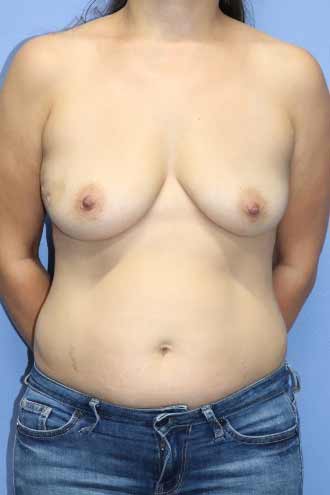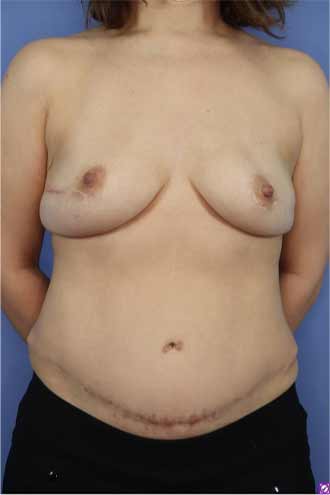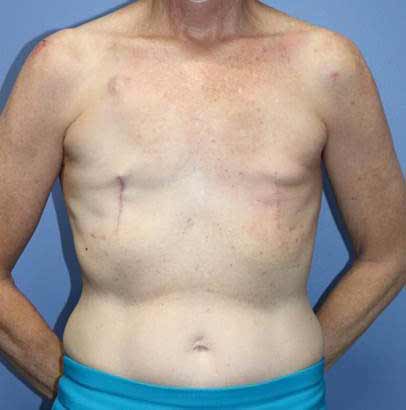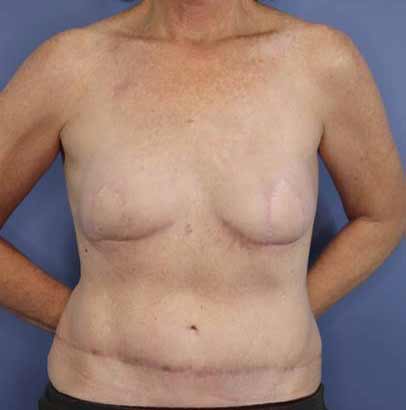DIEP breast reconstruction is a form of autologous reconstruction; it uses tissue from the patient’s own body to recreate the breast after a mastectomy or other injury. Women have options when it comes to breast reconstructions. While implants do make thousands of women happy each year, other women who are considering breast reconstruction are rightfully concerned about the disadvantages of synthetic breast implants. The DIEP flap technique uses advanced microsurgery techniques, connecting tiny blood vessels to create healthy, living breast tissue. If you’re considering breast reconstruction, you know exactly what an incredible gift that is.
Dr. Michael Howard specializes in breast reconstruction microsurgery and has helped thousands of women restore their contours and confidence. He offers his patients a full spectrum of surgical reconstructive options and is a leading expert in DIEP flap reconstruction. To learn more about breast reconstruction, schedule a personal consultation with Dr. Howard. Call (224) 271-4250 to make an appointment at our offices in Chicago, Lake Forest, or Glenview.
Contents
Before and After Photos
About Breast Reconstruction
Reconstruction of the breast can be accomplished in one of two ways: implant-based reconstruction, or autologous reconstruction. Implant-based reconstruction uses a saline or silicone synthetic implant placed under the skin or muscle to recreate the rounded shape of the affected breast. Autologous reconstruction uses a woman’s own tissue from another part of her body to recreate the appearance of her original breast. This type of procedure is commonly called “flap” reconstruction, as it uses a flap of skin and fatty tissue from areas like the abdomen or inner thigh. The flap is then sculpted into a natural-looking breast shape. Because the flap contains blood vessels that can be attached to the site on the chest, the new breast will have the blood flow necessary to thrive. While both breast reconstruction methods are widely performed, the DIEP Flap method of autologous reconstruction offers unique advantages.
What Is DIEP?
DIEP stands for deep inferior epigastric perforator. These blood vessels transport blood from larger arteries through the abdominal muscles to supply the more superficial layers of fat and skin. (1) When Dr. Howard removes the area of tissue that will eventually become the new breast, he also carefully leaves the DIEP attached. These blood vessels are then carefully attached to the existing blood supply in the chest so that once the flap is sutured into place, it has a healthy source of blood and the body accepts it as new breast material. Other flap procedures used for autologous breast reconstructions use similar techniques, resulting in a healthy new breast that moves and feels like authentic breast tissue. Because these techniques use the patient’s own tissue, there’s no risk of the body rejecting the new breast, or long-term side effects.
About Breast Implants
Unfortunately, the same can’t be said for synthetic breast implants. While breast implants are sterile, widely used, and FDA-approved for safety, they do come with considerable risks.

This form of reconstruction has a higher complication rate related to prosthesis failure.
Women with breast implants are recommended to have MRIs every few years to make sure silicone gel implants have not ruptured. They can also interfere with your future routine mammograms. Checking for remaining or recurring breast cancer is more difficult and more uncomfortable.
Patients with larger breasts often need cosmetic adjustments made to their remaining breast in order to achieve symmetry. This can be difficult to gauge when women choose to undergo a reconstruction at the same time as their mastectomy (immediate reconstruction). Even patients with smaller breasts can find that the generic round or teardrop shape of the prosthetic implant is considerably different than the shape of their other natural breast. (2)
Additional Considerations
Depending on the amount of tissue that was removed during the mastectomy, there may not be enough skin to cover the entire surface of the new implant. Insufficient skin surface can lead to a “rippling” effect after the implant is placed. In other cases, a tissue expander needs to be implanted in order to stretch the skin and breast cavity in order to make room for the implant. This requires additional time and surgery.
If you’re looking to avoid future surgeries at all costs, breast implants are not for you. Prosthetic implants are not lifetime devices and will need to be replaced every 10 years or so.
The American Cancer Society explains that certain types of breast implants can be linked to a rare kind of cancer, known as anaplastic large cell lymphoma (ALCL). Although not a form of breast cancer, this lymphoma can happen around 8 to 10 years after the implant is placed and occurs more frequently if the implants have textured surfaces. BIA-ALCL is recognizable as a lump or collection of fluid near the implant and has symptoms that include pain, swelling, and asymmetry.
A Better Breast Reconstruction
DIEP breast reconstruction offers significant advantages over reconstructions with implants.
Women who have endured the pain and uncertainty of cancer treatments deserve a safe and permanent way to feel beautifully restored when they close this difficult chapter of their lives.
Benefits of Autologous reconstruction:
- No future revision surgeries
- Natural movement and feel
- Can mimic the shape of the other breast for symmetry
- Undergoes natural weight fluctuations and the aging process
- No risk of rejection (1)
Candidates
Women considering a DIEP Breast reconstruction are looking for a safe, permanent way to recreate a natural breast after a mastectomy. They’re eager to avoid future surgeries and the complications that synthetic implants pose. Ideal candidates have sufficient tissue in a donor site to form a breast that will be symmetrical to the size and shape of their own breast. This procedure can be performed at the same time as a mastectomy, so if you are anticipating an upcoming mastectomy, don’t delay in scheduling a personal consultation with Dr. Howard. After reviewing your case, he will be able to coordinate with your surgical team to ensure that your procedure provides beautiful results.
Procedure
DIEP flap reconstruction requires advanced microsurgery techniques. However, you would be hard-pressed to find a more qualified surgeon. Dr. Howard has performed over 10,000 procedures and is dedicated to supporting his patients through every step of their reconstruction. When you arrive at Northwestern Medicine Lake Forest Hospital, you’ll be taking advantage of state-of-the-art surgical facilities and an accomplished and caring surgeon. After you’ve been administered the appropriate anesthesia, your DIEP Breast Reconstruction will begin.
- Dr. Howard locates the DIEP blood vessels beneath the surface of your skin, and the donor area is marked
- He carefully excises a crescent-shaped flap of skin is from the abdomen or other donor site with the necessary blood vessels attached
- They are then safely detached from their connecting arteries
- The skin of the donor site is re-draped and sutured closed
- The breast area is prepared to accommodate the flap, which is then fashioned into a breast shape.
- The DIEPs are connected to the breast area’s blood supply, and after final adjustments, the new breast is sutured into place.
- The treated areas are dressed with bandages and the patient is moved to a recovery room
Recovery
Another benefit that DIEP offers women is an easier recovery than that endured after a reconstruction with implants.
Reconstruction with implants requires lifting the chest muscles to place the implant, which contributes to discomfort and significantly limits movement during the recovery. They are also able to avoid the constant ache of pressure that a tissue expander inflicts when preparing the area for the implant. After your breast reconstruction with DIEP, you’ll be up and walking the next day, and will be able to return home within another day or two. Within a week or two, you’ll be able to return to light activity. You’ll be able to return to normal activity in four to six weeks. Dr. Howard will be monitoring your progress during follow-up appointments and will be available for any questions you have. To learn more about the support and life-changing results that his other patients have enjoyed, read his reviews!
Results
Women who choose an autologous breast reconstruction enjoy the satisfaction and peace of mind that the DIEP technique offers. Their beautiful new breast restores balance to their chest, confidence in their life, and allows them to know that they are starting each day as 100% themselves. They can look forward to a natural, soft breast that moves and ages as gracefully as they do. To learn more about how this reconstruction procedure can help you continue living a full life, contact Dr. Howard’s office at (224) 271-4250. Whether you visit us in Chicago, Lake Forest, or Glenview, we’re looking forward to meeting you.
How Much Does a DIEP Flap Breast Reconstruction Cost in Chicago?
The cost of your DIEP breast reconstruction will depend on the details of your procedure. If your insurance plan covers mastectomies, federal law requires that it also cover breast reconstruction. Our staff will be able to assist you in determining your insurance coverage and how to proceed to make this life-changing procedure a reality.
References
- Munder B, Andree C, Witzel C, et al. The DIEP Flap as Well-established Method of Choice for Autologous Breast Reconstruction with a Low Complication Rate – Retrospective Single-centre 10-Year Experience. Geburtshilfe Frauenheilkd. 2020;80(6):628-638. doi:10.1055/a-1116-2102
- Quinn TT, Miller GS, Rostek M, Cabalag MS, Rozen WM, Hunter-Smith DJ. Prosthetic breast reconstruction: indications and update. Gland Surgery. 2016;5(2):174-186. doi:10.3978/j.issn.2227-684X.2015.07.01









